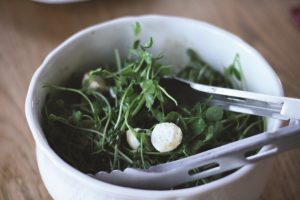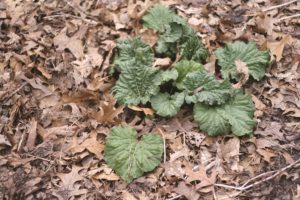The earth is coming alive. Beneath the oak leaves that I pile on my garden plot every fall, I am beginning to see the first sprouts of green. Garlic is waking up, and rhubarb is nudging me. It’s time to start the garden season. But where to begin?
Order Seeds
Seeds are the first dreams of a gardener’s season. Seed companies have been overwhelmed by demand this spring, which means that, while you can certainly still order some from the bigger companies, your choices may be limited. Some companies have reported as many as a third of varieties selling out, others have limited online ordering to certain time windows, and still others are building new packing warehouses.

I recommend turning to local sources instead. Both the Truro and Wellfleet public libraries have seed libraries — large collections that offer free seeds to the public. And teens from the Nauset Food and Research Garden at the high school are selling a locally adapted line of offerings they call “Nauset Seeds” at the Orleans Farmers Market.
One way to get out of the seed race is to focus more on perennials — plants that stay alive year after year. While most people associate them with ornamental garden plants, there are lots of edibles. Take the Egyptian walking onion, for instance: I planted a few bulbs in a corner of my garden, and I’ll never plant an annual onion from seed or set again. The tips of Eygptian walking onions form bulbils, similar to a head of garlic (which can also be grown as a perennial), but more open. Left to their own devices, these bulbils will root and form new plants. You can also pull them off and replant them where you want them, to help the process along.
Asparagus, strawberries, rhubarb, sea kale, and raspberries are other common examples of edible perennials. For more ideas, check out Eric Toensmeier’s Perennial Vegetables.
Prepare the Earth
Some years, I start prepping my garden and planting as early as mid-March. An Irish friend in Truro once told me to plant my sugar snap peas on St. Paddy’s Day, and, most years, that’s been good advice. (You can also start potatoes, radishes, carrots, and many greens that early some years.) But after winters like this — with late snow — I wait. There’s plenty to do before seeds go in the ground to keep busy into April.
Mulch
It’s best to mulch in the fall. After years of trial and error, I’ve decided the easiest (and cheapest) cover where we live, in the woods, is oak leaves. Soil is not meant to be left uncovered — wind, rain, and snow all leach nutrients and blow away topsoil, which is a precious resource, particularly when you live on a sand spit. That said, if you didn’t mulch in the fall, it’s not too late. There are still plenty of benefits to be had from a spring mulching.
I like to start with what I can rake up in my yard after the thaw. The job needs to be done anyway this time of year, and I separate my piles by the dominant tree species. I keep the pine needles for my high bush blueberries — they, like hydrangeas, cranberries, blackberries, potatoes, daffodils, and azaleas, along with some others — like the acidity the needles bring. I keep the oak leaves for everything else.
Some people shred their oak leaves; I don’t have a shredder, but if you do, they yield a finer and more wieldy mulch. I leave my mulch on all through the gardening season. I’ll pull back areas to plant rows of seeds or transplant starts, but once they get established, I push the mulch back into place to keep moisture in the soil and weeds at bay. Over time, the mulch breaks down to become part of the soil, and you can keep piling more on top each fall. Other free and locally abundant mulches to consider include seaweed and salt marsh hay, and if you’re worried about pH or working with a particular crop like strawberries that likes some extra care and lift, you can also buy mulching straw from a garden center.
Green Manure
Did you plant green manure? This is a gardener’s term for plants that are grown specifically to add nutrients to your soil. Some gardeners plant a cover crop late in the growing season that has the added benefit of fixing nitrogen. If you planted a green manure crop in the fall, it’s time to dig it in. You want to avoid letting it get tall and unmanageable or, worse, going to seed.
Soil Amendments

My favorite soil amendment is biochar. Unlike most fertilizers, biochar builds up over time — it can endure in soil for thousands of years. It’s a charcoal that’s produced by pyrolysis (burning woody biomass without oxygen), and it boosts soil fertility by creating a soil structure that retains nutrients and beneficial micro-organisms.
You can make your own, or you can buy it — Redberry Farm makes it locally in Eastham, and it’s available at many garden centers, hardware stores, and farmers markets. It’s more expensive than compost or chemical soil fertilizers, but unlike those it also accumulates. I add some every year. Then I add a layer of compost to any new planting and “spot” fertilize as needed, providing bone meal for tomatoes and following other crop-specific recommendations.
A Garden Notebook
I like to plan out my garden each season in a dedicated notebook, to keep track of what I planted when, and how it did. That’s how I learned that kale planted early in the spring does not seem to suffer terribly from cabbage moths and their caterpillars, whereas kale planted when it’s hot out gets destroyed by these bugs. It’s worth tracking your observations year after year, and it’s fun to look back and remember what you’ve grown. The process doesn’t have to be fussy — mine is covered in soil prints with messy scribbles like “4/2/15 — planted potatoes, trying Pinto.”
First Plantings
There are plenty of early season crops that do well here. Once you see edible weeds sprouting in the wild (think nettles, garlic mustards, wild onions, beach pea shoots, and fiddleheads) it’s warm and bright enough that cultivated plants can and will thrive, too.
I always plant my sugar snap peas first, sometime between March 15 and April 10, followed closely by spinach, kale, Swiss chard, beets, potatoes, carrots, radishes, shelling peas, onions, turnips, cabbage, broccoli, mustards, and lettuces. I also almost always forget to leave enough space for the warm weather crops that will follow. In your enthusiasm, try to remember to leave room for heat-loving plants like tomatoes, zucchini, beans, cucumbers, and squash to find a spot come May. After a long winter, it’s easy to get carried away.



